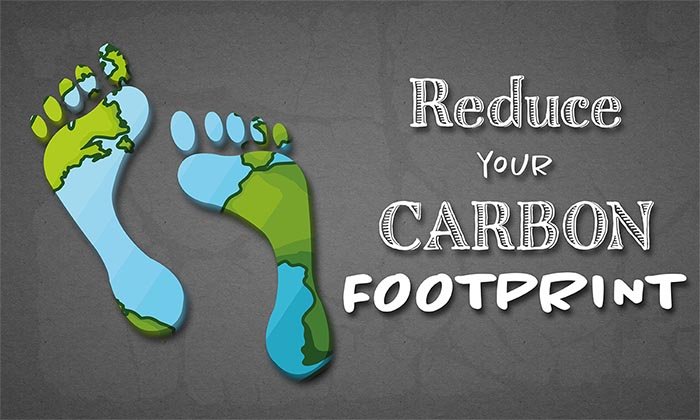You can make a difference by adapting simple ways to reduce your carbon footprint or greenhouse gas emissions. There are many ways to do this, some of which are beyond your ability to make happen. Hearing that putting up solar panels, insulating your home only makes sense for those that have the house and the means to contribute this way. But your home is probably not in a house, so solar panels and many other options are not ways you can contribute to lowering your carbon footprint. That is why these posts focuses on how ordinary people can personally get involved with saving our environment. The suggestions below are not just easy, but some of them require little investment and don’t involve an extraneous use of your time.
What is Carbon Footprint?
Your carbon footprint is the greenhouse gases you use as you go about your everyday life. How do you determine the carbon footprint you produce? Start by using this calculator. But, before using the calculator, let’s define a few terms that may wonder about, especially if you are not what I call green-versed. Review the terms, then click here for an extensive list you can use as a resource you can use to learn more terms and definitions. The goal is to make understanding what you can do as simple as possible. For any change you choose to make as hassle free as possible.
Terms mention in this post
- Carbon Footprint – The impact of activities on the environment base on the measurement of green gas produced.
- Greenhouse gas – present in the earth’s atmosphere, these gases maintain the temperature of our planet. Without them, the earth would be too cold to inhabit, too much of these gases, and the earth would be too warm to inhabit. The gases are produced naturally and man-made. The man-made portion is usually industrial and also known as greenhouse emissions. Emissions mention in this post is referring to greenhouse emissions.
- Per Capita – per individual/per person
- CO2 Emission – The amount of carbon dioxide emitted because of energy consumption
- Methane – A colorless, odorless, flammable gas. It is the key component used to generate electricity, heat in homes and account for at least 10% of human gas emission.
- Energy Star – Equipments that identify as energy efficient by the EPA and the US Department of energy.
- Biodegradable – Products made with a material that breaks down naturally and doesn’t affect our eco-system.
Here are the simple ways you can shrink your carbon footprint
1. Food
The food you eat contributes to man-made global emission. Here is something most people barely think about: The process involved in the productions of certain foods. Let’s use meat as an example. To produce the meat you buy at a supermarket involves creating food to feed the animals that eventually end up on your plate. That process contributes to increases in greenhouse gas emission. The production, processing, and the methane produced from the man-made process, contribute to trapping heat in the atmosphere, which is more potent than CO2 emissions.
I readily admit, most people cannot conceive of not eating meat. It’s what they know, and the idea of not eating meat is not an option. That’s okay! But consider not eating meat every single day. Pick a day, maybe two, and choose to not eat meat or dairy on those days. Every day, you choose to not eat meat contributes to the reduction of your carbon footprint by at least 8 pounds.
Consider buying only grass fed, organic meat. These types of meats are raised naturally and don’t contribute to increasing carbon footprints.
2. Clothes
We each have a unique stance on the clothes we wear. Some would never wear clothes owned by someone else, others would never, ever buy their clothes at Walmart, some love their designer wear and couldn’t possibly buy anything less. This post is not about getting you to change what’s familiar. It’s about asking you to consider how you can continue to do or wear what you love and still try to lower your environmental footprint.
Here is what you should know to make an informed decision. Trendy clothes, cheap clothes, clothes that’s in style, in season and out the next, are the focus. If you fall into any of the above category, what do you do with the clothes you no longer want? Your answer is the key to how you can lower your footprint.
When you decide you no longer want a piece of clothes, and the solution is a garbage can, or a thrift shop that doesn’t have environmental practices, guess where the clothes end up? In landfills. 80% or more of the clothes we discard without a second thought, takes 200+ years to decompose. Also, during the decomposition process, the clothing material generates greenhouse methane gases that ends up leaching chemical and dyes into our soil and groundwater.
You can lower your carbon footprint by making a conscious choice to buy as little trendy clothes as possible. By never throwing your unwanted clothes in a dumpster, or garbage can, and by making sure that if you are giving your clothes to a thrift or consignment shop, that they are not sending their unwanted or unsaleable clothes to a landfill.
3. How you shop
Today, the way you shop are drastically different from yesterday. Changes happen that you have no control over; because of the environment and because of health issues such as COVID-19. Regardless of the reason, don’t fight the changes, don’t get annoyed because you have to bring your own bags to buy groceries. These minor changes reduces your footprint and contributes to a better environment. Below are other reasons slight changes make a difference.
Eco-unfriendly |
Eco-friendly |
Why |
| Plastic bags | Paper or your own | 1000 or more years in a landfill |
| Desktop computers | Laptops | Requires less energy to operate |
| Non-energy-efficient appliances | Appliance labeled Energy Star | Require less energy to operate |
| Cars that just use gas | Electric or hybrid cars |
Eco-friendly= less oil Electric = no oil Hybrid = ethanol or liquid natural gas. |
| Single use water bottle | Reusable water bottles | We purchase every minute 1million plastic bottles. Also headed to landfills, which takes a thousand years to degrade. |
| Disposable batteries | Rechargeable batteries | Landfills and leaching toxic metal in our soil and water. |
| Single-use coffee cups | Reusable coffee cups | Single use cups are not biodegradable because of polyurethane lining. |
4. Your Home
Whether you live in a house in the suburbs, or an apartment building in the city, there are things you can do in your home to lower your carbon footprint. Just remember, everything you can do, no matter how small, is better than nothing at all.
- Change incandescent lightbulbs to LED’s – They cost a little more, but they also last 25X longer, use a quarter of the energy compared to their predecessor.
- Hit the switch – If you are not in the room, then the light should be off. Consider turning off and unplugging small electronics if they don’t need to be plugged in.
- Monitor the use of your thermostat – If you live in a part of the country where heat matters in the winter and cool air matters in the summer, then it’s hard to be conservative with your thermostat controls. Just do the best you can. Only you and your family knows what you can tolerate.
- Use less paper – Instead of reaching for paper towels when you’re in the kitchen or bathroom, reach for dish towels and hand towels. Consider going paperless with your bills
- Use dryer balls – you can get the same results with dryer balls as you would with dryer sheets.
- Recycle – Separate your cans, glass, paper. If you don’t know the recycle pickup schedule for the town you live in, contact the sanitation department.
- Invest in plants – They are the perfect air cleaner and they look good. If you think you can’t take care of plants, you are wrong. Start with one or two, learn about the type you bought, how much light they need and how often you need to water them, and you can’t go wrong.
- Natural cleaners – Where possible, choose to invest in natural cleaners. They can be as effective as the ones you are familiar with, but have fewer chemicals.
5. How you travel
Unless you are a hermit, you leave your home almost every day, either to go to work, school, or myriads or destinations that involves some sort of travel. To lower your footprint, consider these options: If you must drive, choose to be as eco-conscious as possible. If your destination is less than a mile away, consider walking or riding a bike, instead of driving. Air traveling? Don’t book a stop-over flight. If you can carpool, do it as often as possible. Finally, if you are considering buying a new car, it’s a great time to consider investing in an eco-friendly car such as a hybrid or electric car.
Minor changes matter when thinking about your carbon footprint
Reducing your carbon footprint is not something you can do in every facet of your life. That’s a reality. It’s hard to commit a hundred percent because you don’t have the resource or the ability to audit every facet of your life and convert it to an eco-friendly lifestyle. While it would be ideal to adjust your life totally, it’s also okay if all you can do is change a lightbulb, or invest in a reusable water bottle. The goal is to change where you can, when you can. To realize that no matter how small the act, it contributes to the global aim of saving our planet.









Trackbacks/Pingbacks